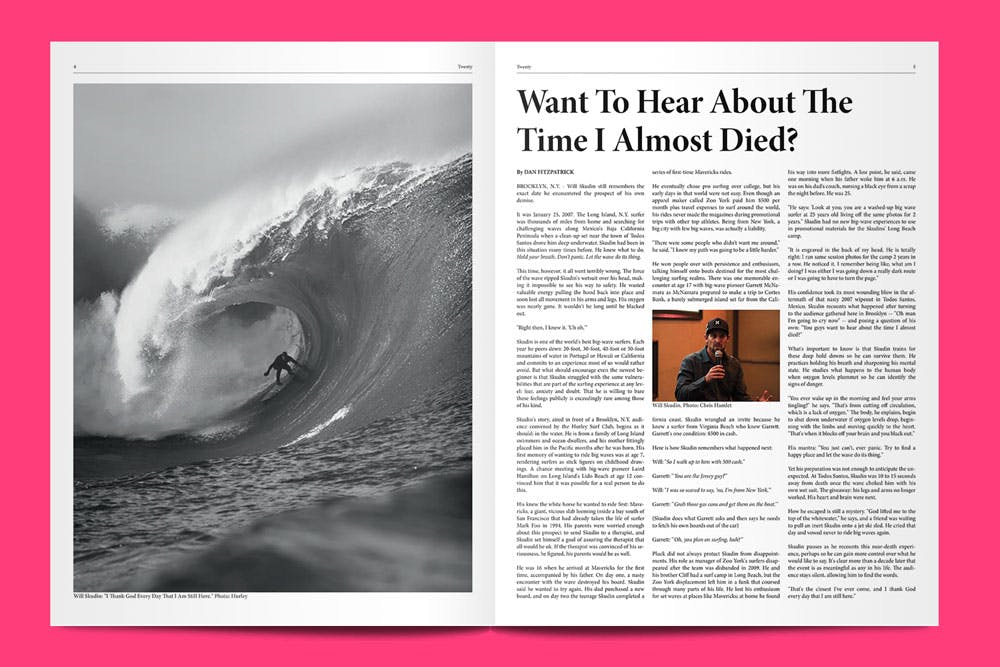The dangerous allure of surfing

A surfing magazine looking to expand the image of who a surfer is, Twenty is named after the perfect score you can achieve in the profession, but its remit is less competitive. The idea is to speak to people who aren’t hard-core surfers, and who might never have got on a board before. Editor Dan Fitzpatrick only fell in love with surfing in his 30s, and found its tribal, insular culture difficult to penetrate. But what fascinated him about surfers, was that irrespective of whether they’re a beginner or a pro, they have something in common: the mad desire to face fear, and failure, and the very real possibility of injury. With Twenty, Dan wanted to tell stories of ordinary people trying to do something extraordinary. To create a different, more accepting community, because as he explains it, “the search for our own version of perfection is what unites all who enter the water.”
Dan talked us through the third issue, and why surfing is so alluring.
We love the size of the magazine, and the style: it’s like a broadsheet. Why did you design it that way?
Firstly it’s a way to stand out, since most surf magazines are printed in a traditional glossy magazine format. The large tabloid also aligns with the mission of the publication: to democratise surfing. A good newspaper offers language that should illuminate virtually any subject for any reader. It also serves as the perfect canvas for our artists, who specialise in bold illustrations that bring to mind the comics of old-fashioned American broadsheets.
The story about pro surfer Will Skudin is striking: his parents were so worried about his decision to ride Mavericks, a dangerous surfing location in northern California, that they sent him to a therapist. Can you explain the allure of surfing — in all its objective madness — to a layperson?
What Will Skudin does for a living — surfing the biggest waves on the planet — is well beyond the abilities of the average person. It’s the equivalent of sliding down the face of a mountain on a slender pane of fibreglass while moving at the speed of a freight train. Only a small percentage of humans will ever be able to attempt it, let alone emerge from the experience unscathed. But there is something here that surfers of all levels have in common, even if it’s seldom acknowledged. To surf is to face fear. Fear of failure. Fear of the ocean. Fear of injury. It takes a lot of courage for anyone to wade into the water and navigate the demands of an unruly ocean. From pros to beginners, we all know what it’s like to encounter a situation beyond our abilities. And we all hope to overcome our jitters in that moment. That test, I think, is a central part of surfing’s allure.
You show a lot of photographs not of surfers, but of ordinary people. What’s the thinking behind that?
Our purpose here is to expand the image of what or who a surfer is — and by extension what a surfing magazine can be. The sport belongs as much to the beginner as it does to the pro. Yet the sport has not done well at providing aspiring surfers with acceptance. I want Twenty to be the place those people can turn to for honour, community and respect. These are people not interested in maintaining secrecy about key surfing spots or manoeuvres. Instead, they want to learn how to pop up on a board correctly and perform basic moves and get stronger in the water. They want to learn how to read waves correctly, how to stay safe and how to find spots that are appropriate for their abilities.
We were interested by this line in the piece ‘The Audacity of Allentown’: “It was clear pro surfing would not become as big in America as baseball or football or basketball.” Is that knowledge something surf fans struggle with? Is it a niche sport? And if so, what does it mean to be a niche sport?
This is a complicated, thorny issue in the surfing world. There is widespread disagreement about whether surfing is even a sport. The professional league that governs surfing was founded in the 1970s and since that time the effort to build an audience among mainstream Americans has faced an uphill climb, even though the best pro surfer of all time (11-time world champion Kelly Slater) is from this country. There are some in the surfing world who still view any competitive event as an attempt to corrupt an activity that represents an escape from the trappings of corporate life. But surfing faces a critical moment in 2020 as it becomes an Olympic sport for the first time. A large audience in America will be exposed to it for the first time. Whether that will launch it into a new stratosphere remains to be seen.
Surfing is so intertwined in the popular imagination with a certain look, certain music and a certain idea about America. Did you think about that making the magazine?
Surfing is certainly associated with numerous traits coursing through American popular culture. Freedom. Rebellion. Daring. Creativity. What I had in mind, however, was an American quality not typically associated with surfing: generosity. The person who embodies that sentiment is Duke Kahanamoku, an Olympic champion and Hawaiian who introduced the sport to the continental U.S. a century ago. Kahanamoku wanted as many people as possible to be exposed to what surfing offered. As he put it in a surfing tutorial published in the July 1929 edition of The Youth’s Companion: “Riding a giant breaker at express-train speed is perhaps the most invigorating and thrilling sport in the world. It combines thrills with endurance, and skill with strength. I know of no other pastime which supplies such a variety of sensations or which assists more in promoting good health, cast iron muscles and perfect coordination of mind and muscle.”







